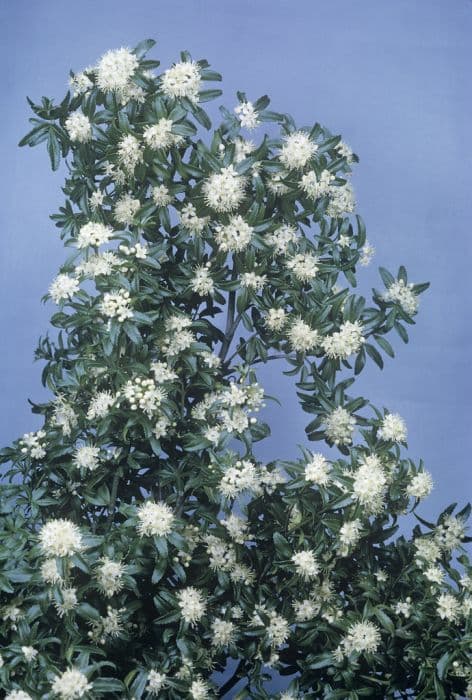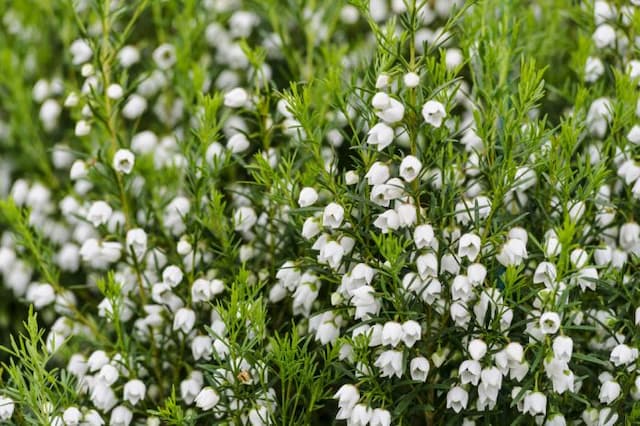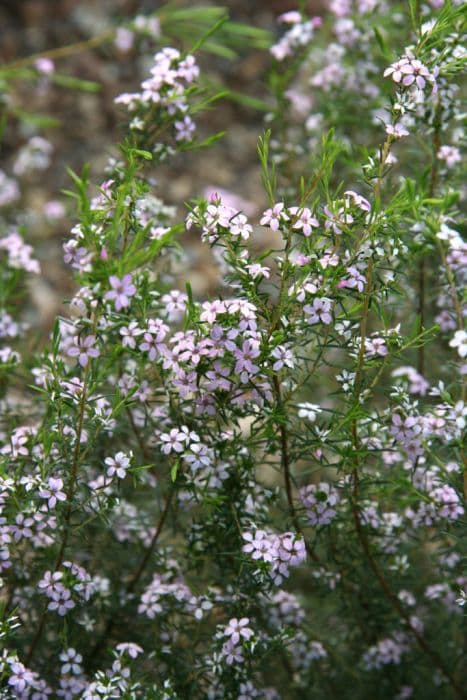Golden Hoptree Ptelea trifoliata 'Aurea'

ABOUT
Ptelea trifoliata 'Aurea', commonly known as golden hop tree, is a deciduous plant known for its distinct foliage and aesthetic appeal. The leaves of the golden hop tree are a key feature—they are compound, typically comprising three broad leaflets that connect to a central point, resembling a trident shape. The 'Aurea' cultivar is specifically prized for its leaves that exhibit a bright, golden-yellow color, which adds a splash of brightness to the landscape. As the seasons change, so does the foliage. The leaves often transition into a greenish-yellow hue, providing an ongoing display of color throughout its growing season. Small clusters of greenish-white flowers bloom in the late spring to early summer, adding to the plant's ornamental value. These flowers are rather inconspicuous yet valued for their subtle beauty and possibly for the pleasant citrus-like fragrance they emit. Following the flowering period, the golden hop tree produces ornamental fruits—round, papery, winged seeds that resemble those of the elm tree. These seeds, often called samaras, hang in clusters and can be quite attractive as they catch the light and move in the breeze. The bark of this tree is another point of interest; it is grayish-brown and furrowed, providing textural contrast within the garden. Overall, the plant's form is rounded and bush-like, with multiple branches creating a dense, full appearance. It's often appreciated for its vibrant colors and the dynamic visual interest it brings throughout the seasons.
About this plant
 Names
NamesFamily
Rutaceae
Synonyms
Golden Hoptree, Yellow Hoptree, Golden Trifoliate Orange, Golden Prairie Trifoliate
Common names
Ptelea trifoliata 'Aurea'.
 Toxicity
ToxicityTo humans
The plant commonly known as Hoptree is not widely recognized for its toxicity to humans. However, consuming any part of the plant may potentially cause stomach upset or allergic reactions in sensitive individuals. Due to a lack of substantial evidence on the toxicity of Hoptree, it is generally wise to avoid ingesting it and to exercise caution, as there can be individual variability in reactions to plant materials.
To pets
The Hoptree is not commonly known for being toxic to pets. Nevertheless, as with many plants, it can potentially cause gastrointestinal upset if ingested by animals. Symptoms could include vomiting, diarrhea, or drooling. Always monitor pets around plants and consult with a veterinarian if you suspect your pet has eaten any part of the Hoptree or is showing symptoms of distress.
 Characteristics
CharacteristicsLife cycle
Perennials
Foliage type
Deciduous
Color of leaves
Yellowish-green
Flower color
Greenish-white
Height
10-15 feet (3-4.5 meters)
Spread
10-15 feet (3-4.5 meters)
Plant type
Tree
Hardiness zones
4-9
Native area
North America
Benefits
 General Benefits
General Benefits- Attractive Foliage: Ptelea trifoliata 'Aurea', commonly known as Golden Hop Tree, boasts eye-catching yellow to golden-green leaves that add a splash of color to the landscape.
- Wildlife Habitat: Offers shelter and food for various species of birds and butterflies, supporting biodiversity.
- Low Maintenance: Typically requires minimal upkeep once established, ideal for gardeners seeking low-maintenance plants.
- Drought Tolerance: Once established, has a good tolerance to dry conditions, reducing the need for frequent watering.
- Adaptable: Can grow in a range of soil types, from well-drained to clay soils, making it versatile for different garden settings.
- Compact Size: Reaches a moderate size that is suitable for small gardens or limited spaces.
- Seasonal Interest: In addition to its distinctive foliage, it features small clusters of greenish-white flowers in spring and ornamental winged seeds in summer.
- Windbreak: Can be used in a hedge or as a windbreak due to its dense foliage.
- Privacy Screen: With its bushy growth habit, it provides privacy and can be used to screen unsightly views.
 Medical Properties
Medical Properties- This plant is not used for medical purposes.
 Air-purifying Qualities
Air-purifying QualitiesThis plant is not specifically known for air purifying qualities.
 Other Uses
Other Uses- Hop Tree's bark and leaves have been historically used in tanning processes due to their content of tannins, which serve as a natural preservative for leather goods.
- The desert-like appearance of Hop Tree can be utilized for xeriscaping, helping to create gardens that require minimal water in arid climates.
- With its bright, golden-yellow leaves, the 'Aurea' variety of Hop Tree is an ideal plant for creating contrasting color schemes in landscape design.
- Hop Tree wood, being tough and durable, has been used in the past for making small wooden articles, such as combs and tool handles.
- The seeds of the Hop Tree, which resemble hops, have sometimes been used as a substitute for brewing beer, particularly in homebrewing experiments.
- Hop Tree, with its dense foliage, can serve as a natural privacy screen or hedge in landscaping, providing year-round seclusion.
- The aromatic qualities of Hop Tree foliage can be harnessed in potpourri blends, adding a unique scent to natural air fresheners for the home.
- As a dye plant, the leaves and seeds of the Hop Tree have been explored for creating natural dyes for textiles and wool.
- The resilient nature of Hop Tree allows it to be used for controlling erosion on slopes or banks, helping to stabilize soil with its root system.
- Insecticidal properties of the Hop Tree have been noted, and it can be included in gardens to organically control certain types of insect pests.
Interesting Facts
 Feng Shui
Feng ShuiThe Golden Hoptree is not used in Feng Shui practice.
 Zodiac Sign Compitability
Zodiac Sign CompitabilityThe Golden Hoptree is not used in astrology practice.
 Plant Symbolism
Plant Symbolism- Resilience: Ptelea trifoliata 'Aurea', commonly known as Golden Hoptree, often symbolizes resilience because it can thrive in a variety of conditions and withstands many environments, from drought to poor soil quality.
- Versatility: The Golden Hoptree represents versatility due to its adaptable nature, being able to grow in different climates and settings, which reflects its symbolic ability to adjust and succeed in diverse circumstances.
- Transmutation: As the Golden Hoptree transitions from its typical green to a vibrant gold in the autumn, it symbolizes change and transmutation, indicating the possibility of positive transformation and the embrace of life’s cyclical nature.
- Healing: Traditionally, parts of the Hoptree have been used in herbal medicine, lending it a symbolic meaning of healing and therapeutic potential, representing the ability to overcome challenges and restore wellness.
 Water
WaterGolden Hoptree should be watered deeply enough to moisten the soil to the root zone, typically around 1 to 1.5 inches per week depending on the weather conditions. During the growing season, water the plant once a week, applying roughly 5 to 10 gallons per watering session for established trees, ensuring consistent soil moisture but allowing the topsoil to dry out slightly between waterings. During hot or dry periods, frequency may need to increase; in cooler or rainy weather, it may decrease. Overwatering or poorly drained soils can lead to root rot, so it’s important to ensure good drainage. During winter, watering can be reduced substantially as the plant’s water requirements diminish.
 Light
LightGolden Hoptree thrives in full sun to partial shade, with direct sunlight for at least four to six hours a day being ideal. The best spot would be one that receives morning sun and afternoon shade, especially in areas with hot summers, to protect it from intense heat. Avoid heavily shaded areas as this plant prefers some bright light to perform well and maintain its vibrant foliage color.
 Temperature
TemperatureGolden Hoptree can withstand a broad range of temperatures, from as low as 0°F to as high as 90°F, but it thrives best in temperatures between 60°F and 80°F. It is hardy to USDA Zones 4 through 9, demonstrating good cold tolerance. However, extended periods outside this temperature range, either too cold below freezing or excessively hot above 90°F, can stress the plant.
 Pruning
PruningGolden Hoptree requires little to moderate pruning, mainly to shape the tree and remove any dead or damaged branches. Pruning should be done in late winter or early spring before new growth starts. Occasionally, thinning out older branches may be necessary to improve air circulation. Regular pruning isn't needed, but maintenance to keep its desired form and health should be assessed annually.
 Cleaning
CleaningAs needed
 Soil
SoilThe Golden Hoptree thrives in a soil mix that is well-drained and rich in organic matter, with a slightly acidic to neutral pH of 6.0 to 7.0. A blend of garden soil, compost, and a small amount of sand or perlite for drainage will create an optimal environment for its growth.
 Repotting
RepottingGolden Hoptree does not require frequent repotting and can often be left undisturbed for several years. It should be repotted when it becomes root-bound or the soil is exhausted, typically every 3-5 years.
 Humidity & Misting
Humidity & MistingGolden Hoptree prefers moderate humidity levels but is quite adaptable and can tolerate the lower humidity levels often found in typical home or outdoor environments.
 Suitable locations
Suitable locationsIndoor
Ensure bright, indirect light and room to grow.
Outdoor
Full sun to partial shade, sheltered from strong winds.
Hardiness zone
4-9 USDA
 Life cycle
Life cycleThe Ptelea trifoliata 'Aurea', commonly known as Golden Hoptree, starts its life when a seed germinates, often in the spring following a period of cold stratification. The seedling develops a root system and a shoot that pushes above the soil surface to unfurl its characteristic trifoliate, golden-yellow leaves. As it matures into a sapling, the Golden Hoptree develops a woody stem and a more extensive root system, while continuing to produce the dense, shiny foliage for which it's known. It reaches maturity in several years, at which point it starts to produce small, greenish-white flowers in clusters, typically in late spring to early summer, which are followed by the development of papery, winged fruit that disperse seeds for the next generation. Throughout its adult life, the Golden Hoptree may continue to grow in both height and spread, exhibiting increased leaf mass and thicker branches. The plant has a life span of several decades, during which time it may experience cycles of growth, flowering, and fruiting annually, until senescence leads to a decline in vitality and eventually death.
 Propogation
PropogationPropogation time
Spring-Early Summer
The common name for Ptelea trifoliata 'Aurea' is Golden Hoptree. Among the various methods of propagation available, the most popular method for the Golden Hoptree is by seed. The best time to collect seeds for propagation is in the autumn when they are ripe. To propagate by seed, one must first stratify the seeds, which involves subjecting them to a period of cold to mimic winter conditions, typically for about 60 to 90 days. Then, the stratified seeds can be sown in a well-draining soil mix, either in containers or in a nursery bed. They should be planted at a shallow depth, just enough to cover the seeds with soil. Successful germination typically occurs in the spring following stratification, and patience is required as the germination process can be slow and irregular.


![Mexican orange [Sundance]](/_next/image?url=https%3A%2F%2Fplants-admin.emdemapps.com%2Fimages%2Fplants%2F%2Fimages%2F604b5381bcf0d.png&w=640&q=75)






